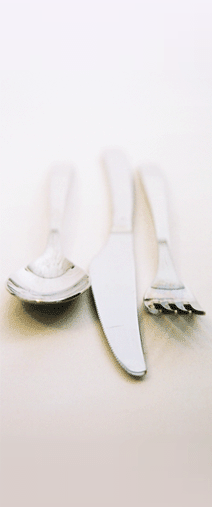Lost in Translation Thirty
January 14, 2009
15:47 PM
When Sile and I went to work in France, in Anjou in the early seventies our place of work was called the Chateau de Teildras.
Now we translated Chateau, as most people do, as Castle. Teildras, to our surprise turned out to be a stately home much more that a castle. It had no sign of fortifications or great stone battlements as one would expect in a castle, it was a very old house, with some some stunning features and a lot of stone walls inside.
The French, like the English and us in Ireland have lots of different names for their old buildings.
Take Bastille, as the one in Thezan which I did a recent blog about reminded me.
I have always assumed there was only the one, in Paris which was stormed in 1798 lighting the spark for the French Revolution.
In fact the word can mean any fortress, and as such is more allied to our conception of “castle” than “chateau”.
Another interesting word is the French Donjon which translates as “Keep” in English and not dungeon, or prison cellar as you would expect.
The Donjon in France is usually a fortified castle rather like our Tower House here in Ireland and was intended to be the last bastion for the lord of the manor in times of war. Its roots come originally from the word Dominus meaning Lord.
Mind you the words are not unconnected, both the dungeon and the tower would be the safest place to keep out of danger in times of war.
And there I notice another defensive word has crept in in the last few sentences; Bastion.
According to the Oxford Dictionary, a bastion was a defensive tower often one which would stand in the centre on the castle and offer a last defence, in fact rather like a Donjon or Keep.
Then there is Bastide, which must be related but means different things in different places.
In the South West of France it means a fortified, usually hilltop village, rather like the Circulades of the Languedoc.
In Provence and the Languedoc a Bastide however is a castle,or manor house, which they would call a chateau in other parts of the country…..which……
Brings me right back to where I started.
Notre Dame de Thezan
January 13, 2009
14:36 PM
I am so pleased to see that the whole phemonenon of the moving statues has come back into vogue in Ireland again.
About time too.
I was begining to fear that it had gone completely.
When we bought our old presbytery in Languedoc one of the things which came with the house was a life sized statue of Our Lady of Lourdes which stands in the courtyard under the terrace.
She is a lovely and serene lady and we have never had any intention of letting her go.
It was my friend Siobhan who suggested that if we could get her to move a little maybe it would be good for business when we opened up the chambre d’hote.
She pointed out that Knock hadn’t done too badly out of a similar occurance.
So with impeccible timing, just about six months before we start looking for customers we have discovered that we may be sitting on (or just over on the terrace) a gold mine.
Now all we have to do is persuade her to move just a little.
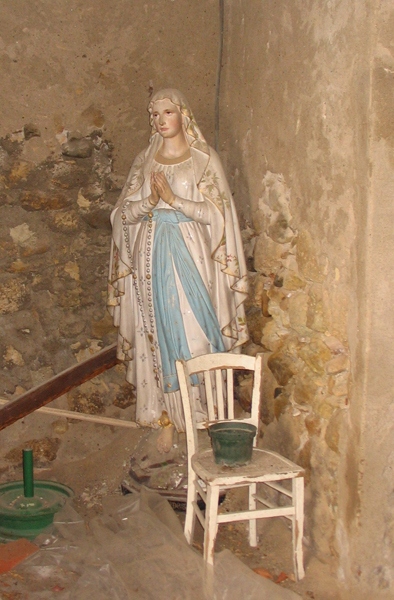
Shelf Clutter
January 13, 2009
12:41 PM
I am a great gatherer of clutter, throwing stuff out requires an effort which goes against my instincts.
We did make heroic sacrifices and gave to friends, charity shops, auction houses and skips an enormous amount of our chattels when we moved from Mary Street (3000 sq. feet) to Griffith Place (900 sq. ft.)
The trouble is that now, having acquired our place in France (3000sq. ft.) there is much we discarded that we now long for in vain.
This doesn’t help at all when we try and de-clutter Griffith Place.
A couple of years ago my friend Clive put up a comprehensive set of shelves for us in our living room, making it look like a small library, and he also put up a shelf all along our kitchen , high enough to be just useful only for ornamental objects,intended, in other words, for clutter.
Since then every time we move down to France we bring large amounts of this stuff with us.
Last July we filled the car with books, 12 large shopping bags full, these now
live still in their bags in the cellar in Thezan.
This , you would imagine would have made a difference to our sitting room /library situation.
But not at all !
The shelves immediately filled up of their own accord and we are now having to put double layers of books on some shelves to keep them off the floor.
We have also managed to bring most of my collection of glass down to France.
These now also live in the cellar in boxes there.
So what remains on our shelf in the kitchen is now just clutter.
This morning I thought about doing another decluttering exercise and looked at one (small) section of this shelf to see what could be discarded.
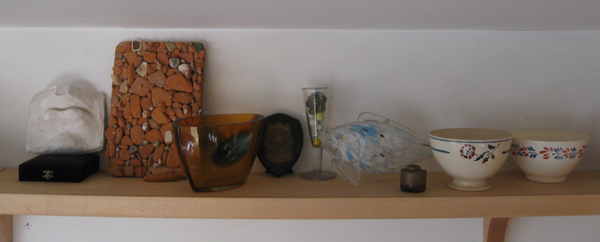
This is it.
I had a good look at it and….. I’m sorry but it is not going anywhere (except maybe to France.)
What may well look like rubbish to you is quite different to me.
Here is its story, from left to right:
Strange bas relief of a face is a work-in-progress for a sculpture by my brother-in-law Martin Lyes. I saw it in his shed and he threatened to throw it out.
I kept it.
It sits on a velvet case which holds a medallion of the Euro-Toques logo which Bulgaria presented to me, possibly as a bribe to get my vote to vote them into the organisation.
It worked.
Next is a picture made of worn pieces of Languedoc red tiles which I found on the beach in Collioure, and which I then, in a moment of creativity, decided to glue on to an old blackboard as a collage.
It took ages, it stays.
In front of that is a piece of experimental glass sculpture made by Waterford to give to American buyers in 2000 as an example of their versitility. They had the dinner to show these off in my restaurant and I somehow was left with one of the pieces.
As you will know now, the whole plan was a bit of a failure.
But as a one off it may yet make my fortune on Antiques Roadshow.
Nearly hidden behind that is a blackened with age shield, totally worthless except to me. It records my being presented with a best actor award in the Universities Drama festival in about 1968.
Next is an old French Champagne glass, picked up somewhere in a junk shop and now filled with old marbles which are actually made of marble and which I have gathered over the years.
Then comes the frigger, a piece of glass made on their own time by a glass worker with scraps from the Waterford factory, (and another possible fortune maker)
In front of that is an old ink well which one of my children found in a stream when we were having a drink one afternoon in a pub in Halfway House.
Then there are two coffee bowls, both with spongeware motifs, picked up at different times in brocantes in France.
I’m keeping all of these!
Let him who is without clutter discard the first one.
1 comment.
Finding the Bastille
January 11, 2009
18:17 PM
I had seen an old photograph taken of the Bastille in Thezan in the early part of the 20th century but had assumed that it was long gone.
I was surprised then to find this photo, obviously contemporary, on the Thezan website.
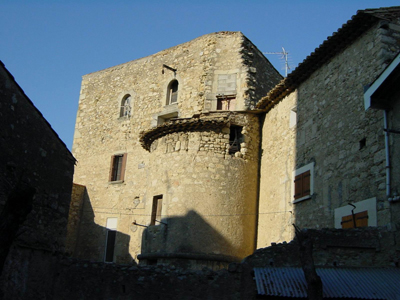
As Sile, brother-in -law Colm and I were there for a few days after Christmas we decided to set outselves up as detectives and find the Bastille.
Studying the above photo we decided that the Bastille had to have been in the original walls of the town and it also seemed to be in a part of a private house.
Our solution seem to be to travel through the myriads of tiny Ruelles and Impasses around the walls and try and peer through gaps in walls and gateways to find it.
Then I had a brainwave, surely one could make out the distinctive demi-lune tower from an aerial photograph?
Forthermore we had just such a shot in last July’s Bassin; the magazine of the town.
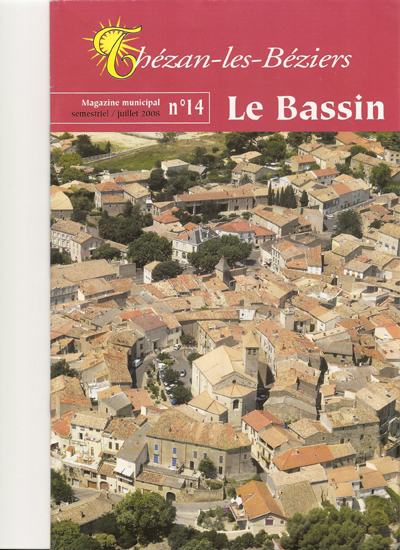
Sure enough with careful peering we thought we located a possibility, right at the end of a previously unexplored Impasse (for the uninitiated, Impasse is the French for Cul-de Sac. Yes!)
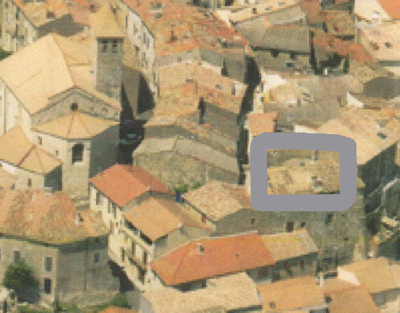
And then , following our noses we did find it and this is the shot Colm took.
It was surrounded by Private, and Keep Out notices but we took this shot from outside the portal.
It would be interesting to get inside though……………..
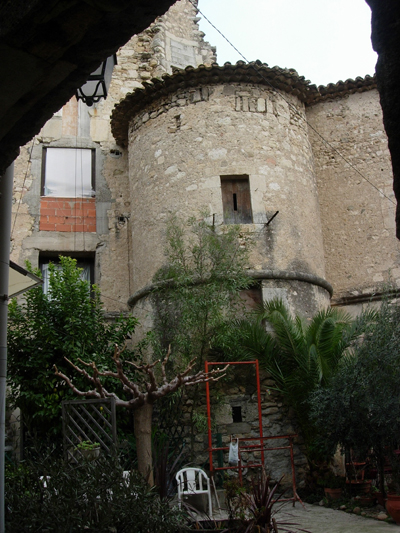
3 comments
Thezan Door
January 8, 2009
22:20 PM
I was in Thezan last week, the weather was really good.
Lovely sun during the day, we actually ate lunch on the terrace.
We thought the nights were cold, until we came home.
This is a door which I pass every morning on the way back to the house with the bread from the baker.
Amazing door but an even more amazing knocker.
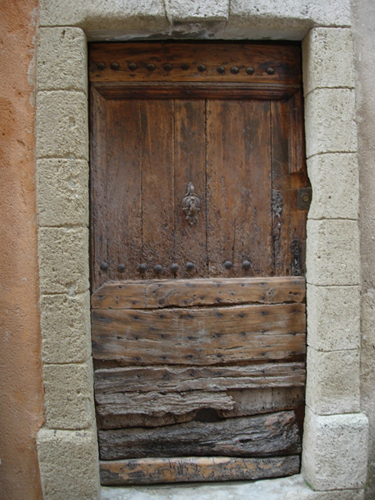
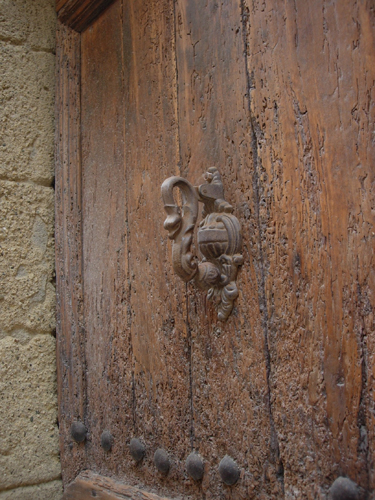
My Mother, the Heretic
January 8, 2009
14:49 PM
My mother,was a heretic.
Even though she went to mass every day,
She refused to believe in Hell
She said:
“God is too good to allow
Anyone to go there.”
As I get older
(And of course no longer believe)
I hope more and more
That she is right.
The River Orb in January
January 7, 2009
23:19 PM
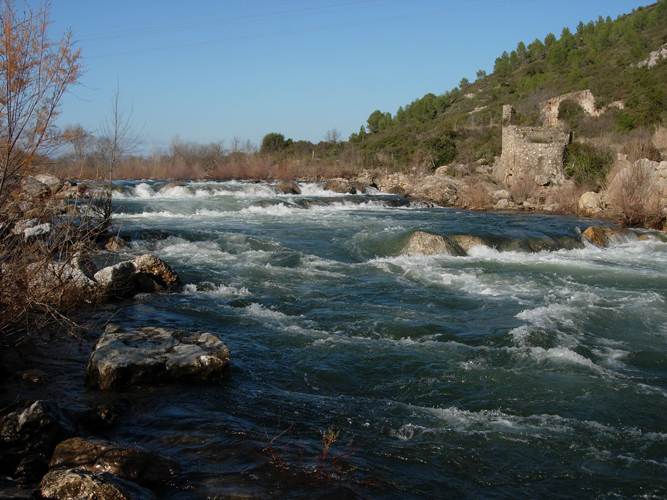
In Thezan last week, without a camera, this is a shot taken by the Brother-in law, Colm, in Cessanon.
Comeragh Walk
January 7, 2009
23:06 PM
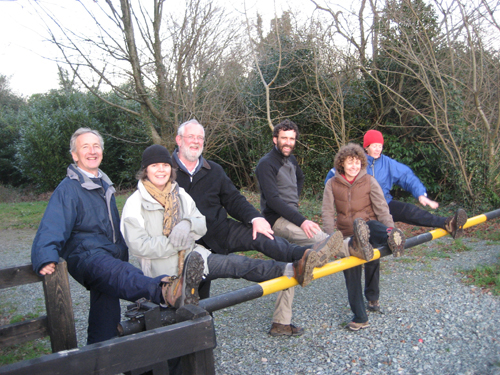
Just after Christmas we always, well for the last ten years or so, go with a group of friends for a walk in the Comeraghs, this year was no exception, thanks Finola for the shot.
John, Sile, Martin, Micheal, Sonya and Grace exercise at the barre.
2008, That Was The Year That Was.
December 30, 2008
18:53 PM
I remember a very sophisticated London Theatrical type coming to run the Group Theatre in Cork while I was at University there.
He used to stun us all by talking of pre and post “TW3” humour.
Eventually one of us poor hicks from Cork summed up the courage to ask him what the hell “TW3” was.
Apparently there had been a television programme in England called “That Was The Week That Was” which was reckoned to be ground-breaking.
The fact that we in Cork at that time could only recept RTE 1, was not considered relevant by this particular person.
In fact now that I think about it he was a fairly pretentious little bollox all round- but the following piece has absolutely nothing to do with him- I was just trying to remember where I got the title from.
At this time of the year it is I think rather fun to remember some of the bits that stick out in ones memory, so here, in no particular order except a vague chronology are some of my highlights of the year.
Hugh Fearnley Wittingstall’s very successful Chicken Out campaign.
Being short listed for Best Food Blog was a thrill.
Discovering that through the wonders of the internet it was possible to talk to anyone one wanted, and, thereby talking to the great David Crystal about linguistics, and to food hero Tom Jaine about “Food God “(and his step father) George Perry-Smith
It was a year of several Unprovoked Doggeral Attacks, notably for my brother-in-law Milo’s Eightieth , Nephew Martin’s wedding to Suzie and sister-in-law Una’s birthday.
Work proceeded apace in the Presbytere in Thezan, the builder particularly doing a beautiful job and Clive and I finishing the year in style with a successful Dining Room Floor
2008 was the year I became a (lower case) journalist, having three pieces accepted by the Irish Times, enough to inflate the Dwyer ego even further.
We had another superb summer in France, our third, with beautiful weather and loads of friends visiting. Roll on the future.
September brought a fantastically successful Terra Madre to Waterford, thereby installing Slow Food firmly in Ireland. Huge credit to Darina Allen and Donal Lehane.
Then Barack Obama Won!
Daughters are always a great source of joy and our three did well this year.
Eileen delighted us with her new boy friend, Caitriona with her news of oncoming babby, and Deirdre with her terrific achievement on winning the Pat Murray Bursary.
The Dwyer Book Launch was a terrific moment and the culmination of a lot of work, again thanks to Mary Leland, brother Ted and Sister D, they played a stormer! Donal Musgraves excellent end of year review in the IT was remarkable.
I will exit with a photo, not one of my own but my favourite one of the year taken cleverly by beau-frere Colm, through his binoculars in February of the Pyrenees from the terrace in Thezan.
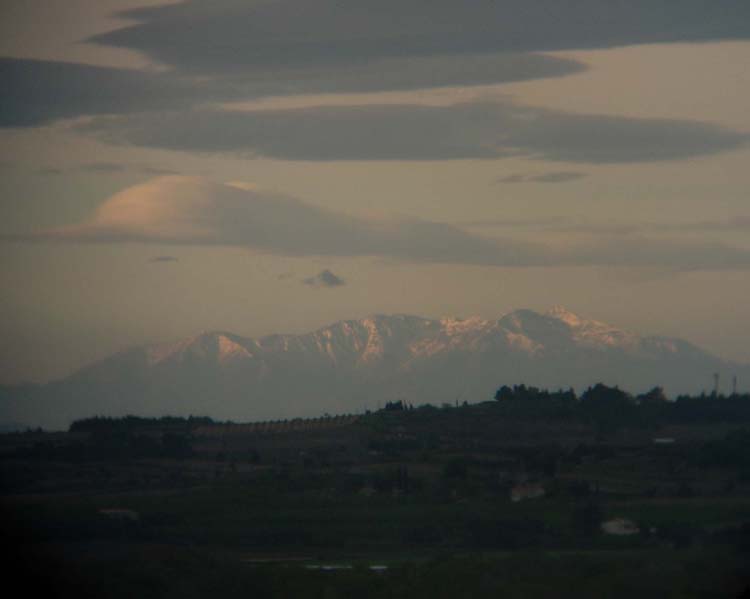
1 comment.
An Irishman’s Diary
December 30, 2008
12:11 PM
Today’s An Irishman’s Diary
by Donal Musgrave
in the Irish Times
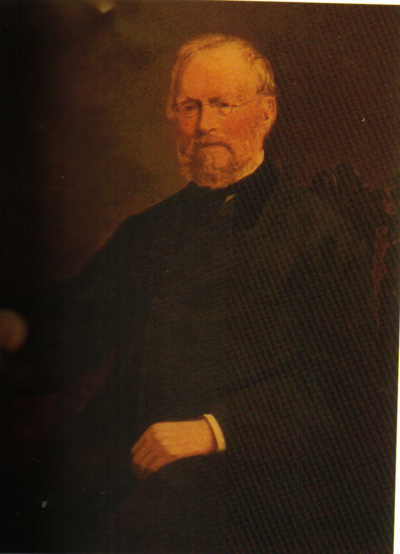
James Dwyer (1798-1889), founder of a dynasty of Cork merchant princes that flourished up to the 1980s
‘Are you one of the ____s? This question, strangely peculiar to Cork, invariably crops up if your name happens to be Dwyer, Musgrave, Crosbie, Mahony, or some other such appellation redolent of the city’s merchant class.
Whether one’s surname reeks of faded glory or smacks of current wealth and power, at a dinner party or over a pint it can give rise to a pointed query.
As Martin Dwyer recalls: “Growing up in Cork in the fifties and sixties I was always aware of a certain privilege attached to the name Dwyer. When introduced to someone new there was always that little flicker of the eyes and the question: ‘Are you related to. . ?’ ”
Mary Leland’s Dwyers of Cork is a lively, fascinating and comprehensive work, full of social, economic and historical insights, depicts the city of the merchant princes in its heyday.
The picture inside the front cover says it all. The 1913 wedding party photograph of the marriage of William Dwyer and Agnes Harding shows strong women bedecked in their finery flanked by comfortable, relaxed-looking businessmen brimming with the confidence bred of success. Underlining the economic importance of the union, there are two priests.
William was the grandson of James Dwyer, the 19th-century founder of a family dynasty that flourished up to the 1980s, while Agnes was the grand-daughter of John Francis Maguire, founder of the Cork Examiner. Although not what you would call a “made marriage”, theirs was a marriage “within a class”, writes Leland – “almost within a caste, an elite born from what Oscar Wilde called the purple of commerce”.
Intriguingly, given Ireland’s growing obsession with “roots” and family trees, it was an outbreak of curiosity among the present-day members of the family about their antecedents, and their subsequent efforts to identify the various Dwyers and Maguires in the photograph, that prompted this publication.
With deft brush-strokes and a journalist’s eye for detail, Mary Leland weaves a colourful tapestry of Cork’s social, family, business, economic and political entanglements.
From the outset, James Dwyer symbolised the emergence of powerful middle-class Catholic families in Cork and the gradual decline of the Protestant upper classes. Pre-eminent among the new breed of innovators and manufacturers, he was in fact a blow-in from Tipperary. In his day, however, he was to become one of the most prominent and influential of Cork’s citizens.
An entrepreneur long before the word was in vogue, he founded a family business that was to last for over 160 years. Between the 1820s and the 1980s, from their base in Washington Street, the Dwyers built up an empire that employed thousands of people in a manufacturing conglomerate that included such names as Sunbeam Wolsey, Seafield Gentex, Perdix Shirts and Knitwear, Templemichael Mills, the Lee Boot Factory and Hanover Shoes.
Reflecting the business flair of the man who went on to establish a dynasty, he “took leave to inform his customers on August 25th 1827, of ‘a large addition to his former stock on the most advantageous terms’.”
Newspaper advertisements described an Aladdin’s Cave of “pearl, bone and horn buttons, studs, Raven and Japan sewing silks, coloured silk galloons, tapes, bindings, hooks and eyes, hat bindings, buckles and bands, cottons and silks and worsted suspenders, rich Parisian fringes, rich bell ribbons and ropes, coach-makers’ trimmings, cottons and silks, garters, wig powders and wafers, gilt, lacquered and black cloak clasps”.
Towards the end of the 19th century James Dwyer attributed a doubling of sales largely to the efficiency of employees. In recognition of their efforts, “we have set aside for distribution amongst them as bonus a substantial sum out of the profits of the past year”. Incidentally, he hoped the move would have the effect of “stimulating increased exertion”.
As Mary Leland observes, “a bonus must have meant a lot to the workers at a time when junior clerks might earn as little as 12 shillings a week and the average annual salary of shop assistants came to £20. Women on the factory floor for a 56-hour week in 1900 were lucky to be paid as much as five shillings.
Among those earning a general salary of £10 a month was Terence McSwiney, a future Lord Mayor of Cork, who was to die on hunger strike in Brixton Prison in 1920 – a death which drew the attention of the world.
Through Leland’s in-depth research and the clarity of her writing, we get a fascinating insight into the profound influence of the “Dwyers of Cork” on the life and times of the city over a period spanning more than a century-and-a-half.
By the 1980s, however, the sun was setting on a business empire which once provided the Dwyers with all they wanted – houses, cars, servants, grooms, stables, school fees, holidays, clothing furniture and fittings.
Thanks to the business acumen of Ted Dwyer, publisher of the family history, you can buy this richly illustrated, 188-page coffee-table book for €30. It’s an ideal present for anyone interested in the history of Ireland’s “real” capital city.
1 comment.
|
